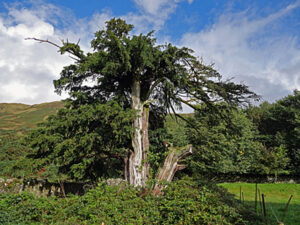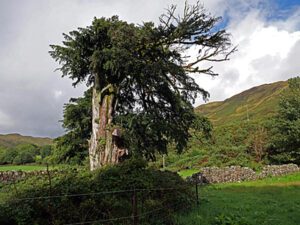“Bow of yew from Esragin (sic)Eagle feather from Loch TreigYellow wax from Galway TownAnd arrow-head made by Mac Phederan”


The trunk of the yew divides into two stems at 50 cm high and both are a mixture of exposed decaying sapwood and fluted bark. The smaller stem is hollowed at the base. The yew was fenced off about ten years ago by the current occupiers of the house to protect ponies and horses from grazing on it as the yew is mortally toxic to them. Consequently a dense extent of brambles and nettles and other plants have established themselves around the base of the yew making a full girth measurement impossible at present. The fencing is now no longer needed, and the area will be gradually cleared to the base of the trunk in the coming months. After clearing away some of the undergrowth only a partial girth measure of 290 cm was possible at the time of the visit and was taken at 50 cm high below the bifurcation. This approximates to 50% of the girth and suggests the full girth at 50 cm high is 500 – 600 cm or slightly more.
“This is, as far as I can tell, the first Scottish West coast yew ever to be analysed using dendro [chronology]. It’s the most northerly for sure….250+ rings…is a pretty good sign of a very old yew. The branch grew to the sampling point in the latter half of the 1700s….taking onto account the sample point the yew itself is certain to date to earlier than 1650.”

An origin pre-1650 would confirm this yew is older than the largest girth yew recorded at Ardchattan priory (300cm @ 150 cm high) and is indeed the oldest so far found remaining in the Esragan area and outside the grounds of the priory. It is, as local traditions claim, the last known survivor of the celebrated yew population of the ‘Esragan’ area.